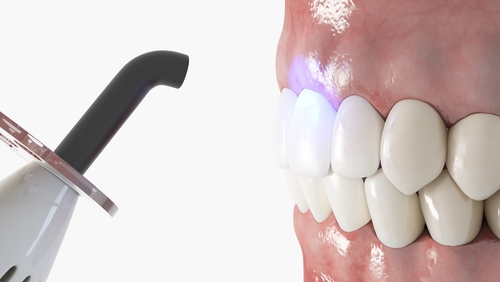Dental Bonding
Elevate Your Smile With Dental Bonding
At Smile Expert, our accredited cosmetic Chula Vista, CA dentist, Dr. Nick Addario, prioritizes your dental health and your confident smile. Dental bonding is a simple yet effective solution to various dental imperfections. Whether you’re dealing with chipped, cracked, or discolored teeth, or even small gaps between teeth, bonding can work wonders to restore your confidence and enhance your smile. This non-invasive procedure involves applying a tooth-colored resin material to the surface of your teeth, sculpting it to perfection, and then bonding it in place with a special light.
Say goodbye to dental flaws and hello to a brighter, more radiant grin by calling (619) 626-2004 to speak to our Chula Vista dentist.

What is Dental Bonding?
Dental bonding is a cosmetic dentistry procedure that involves applying a tooth-colored resin material to the teeth to enhance their appearance. This versatile treatment can address various dental issues, from chips and cracks to discoloration and gaps between teeth.
Benefits of Dental Bonding
Dental bonding offers various benefits, including:
- Improves the appearance of teeth: Dental bonding is an effective way to enhance the aesthetics of your smile by addressing minor imperfections such as chips, cracks, and discoloration.
- Corrects minor cosmetic imperfections: Whether you have small gaps between your teeth or irregularly shaped teeth, dental bonding can help correct these issues, giving you a more symmetrical and uniform smile.
- Preserves more natural tooth structure compared to other procedures: Unlike procedures like veneers or crowns, which may require significant removal of tooth enamel, dental bonding typically involves minimal alteration to your natural teeth, helping to maintain their integrity.
- Quick and painless process: Dental bonding is a relatively quick and straightforward procedure that can often be completed in a single visit to our clinic. Moreover, it is typically painless, requiring little to no anesthesia in most cases.
- Cost-effective solution for smile enhancement: Compared to other cosmetic dental procedures, such as porcelain veneers or dental implants, dental bonding is a more budget-friendly option for improving the appearance of your smile. It offers excellent results without breaking the bank.
Who is a Candidate for Dental Bonding?
You may be a suitable candidate for dental bonding if you:
- Have minor cosmetic imperfections on your teeth
- Want to improve the appearance of your smile without extensive dental work
- Have good oral health and hygiene habits
- Are looking for a non-invasive and affordable cosmetic solution

Dental Bonding Process
- Consultation: Your Chula Vista dentist will examine your teeth and discuss your goals to determine if dental bonding is the right option for you.
- Preparation: Minimal preparation of the tooth surface may be needed, such as roughening the enamel slightly to help the bonding material adhere better.
- Bonding: The tooth-colored resin material will be applied to the tooth and sculpted to achieve the desired shape and appearance.
- Curing: A special light will be used to harden the bonding material and bond it securely to the tooth.
- Finishing: After the bonding material is cured, your dentist will trim and polish it to blend seamlessly with your natural teeth.
Dental Bonding Aftercare
To maintain your results after the dental bonding procedure, it’s essential to follow these tips:
- Avoid biting on hard objects or using your teeth to open packages.
- Practice good oral hygiene by brushing and flossing regularly.
- Schedule regular dental check-ups to maintain the results of your dental bonding treatment.
Frequently Asked Questions
How long does dental bonding last?
Dental bonding typically lasts between 5 to 10 years, depending on factors such as oral hygiene practices, eating habits, and the location of the bonded tooth. With proper care and regular dental check-ups, you can prolong the lifespan of your bonding.
Is dental bonding reversible?
Yes, dental bonding is reversible. Unlike some other cosmetic dental procedures that may require irreversible alteration to your natural teeth, bonding can be removed or replaced if needed. However, it’s essential to consult with your dentist before making any decisions regarding the removal of bonded material.
Can I eat normally after getting dental bonding?
Yes, you can resume your normal eating habits after getting dental bonding. However, it’s advisable to avoid biting down on hard objects, such as ice cubes or pens, as they can potentially damage the bonded material. Additionally, practicing good oral hygiene and avoiding excessive consumption of foods and beverages that may stain your teeth can help maintain the longevity of your bonding.
Can dental bonding fix large gaps between teeth?
Dental bonding is most effective for correcting small to moderate gaps between teeth. For larger gaps or more extensive cosmetic issues, alternative treatments such as orthodontic treatment or dental veneers may be more suitable. Your dentist can assess your specific situation and recommend the best course of action for achieving your desired smile goals.
Achieve a Radiant Smile at Smile Expert
At Smile Expert, we’re dedicated to providing you with personalized dental care solutions that meet your needs and exceed your expectations. With dental bonding, you can achieve a beautiful, confident smile without extensive procedures or breaking the bank. Contact our Chula Vista, CA dental office today by calling (619) 626-2004 to schedule a consultation and take the first step towards enhancing your smile!
Office Hours
Tuesday: 8am to 5pm
Wednesday: 8am to 5pm
Thursday: 7am to 4pm
Friday: 7am to 3pm